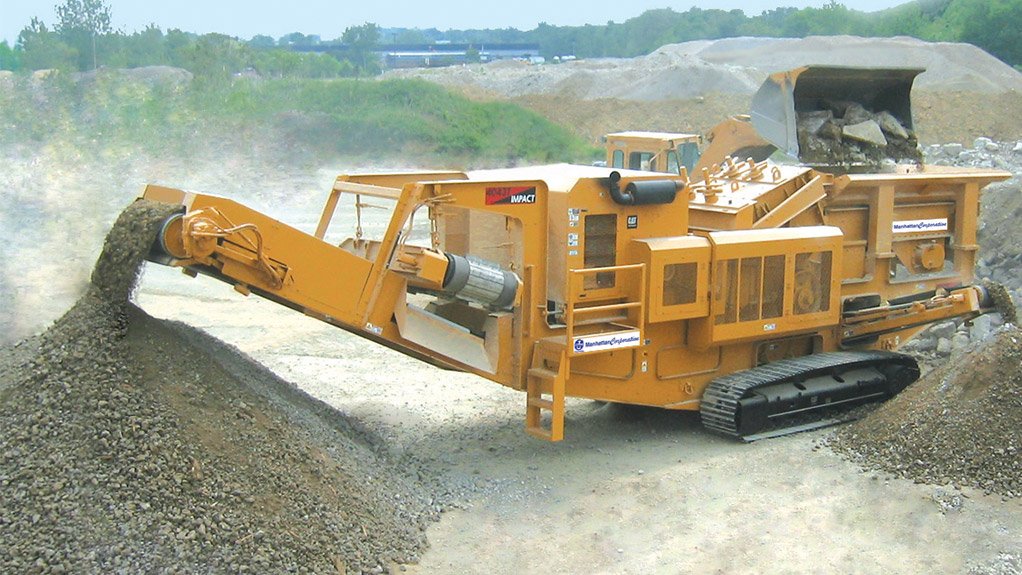Crushing process enhancements to boost quarry production


CRUCIAL IMPORTANCE Understanding the correct types of crushing processes required to manufacture the necessary products in the required tonnages is vital knowledge
Optimising crushing processes is a reliable way of boosting a quarry’s production with benefits that extend from extraction of materials to the stockpile and sale of graded products, states process technology and services provider Metso Minerals Southern Africa construction GM Alan Fletcher.
Fletcher, who is a crusher specialist, was invited by the Aggregate and Sand Producers Association of Southern Africa (Aspasa) to address crushing and screening efficiency in a special crusher optimisation workshop held for Aspasa members last month.
He notes that a bottleneck at any of the stages of the screening and crushing process can have a dramatic effect on overall production, including a negative impact on the profitability of a quarry in the long term.
“The single most important aspect of rock processing is safety and training of all staff in the correct operation and procedures when operating heavy processing equipment,” Fletcher highlights. Thereafter, it is vital to understand the types of crushing processes that will be required to manufacture the necessary products and to procure the right equipment to deliver the required tonnages.
“Once we have established the type of product and tonnages required, we can build the processing plant around those principles and determine the types and amount of crushers required,” he says.
Fletcher explains that the typical quarry plant will have primary crushers, such as jaw crushers, at the first stage of production. Materials will then go to secondary crushing, where cone crushers are typically used, after which it will proceed to tertiary crushers if finer materials are required. Quartinery crushing is sometimes used to make materials finer still.
“As it takes comparatively little energy to break large lumps and considerably more energy for smaller stones, each time the particle is reduced further, plants need to be designed for efficiency to work out the correct pinch point to break the material quickly and efficiently,” reiterates Fletcher.
Ensuring Efficiency
He adds that, regular checks and clearing need to be done, particularly on feeders, screens and scalping screens.
“Even a 10% build-up of materials on a screen can have a substantial effect on efficiency, as it will block 10% of the material. Moreover, it will recirculate missed material and cause a build-up, further compounding the problem,” he explains.
As screen size and stratification determine the amount of material that is delivered to the crusher, it is therefore important that the screen is correctly specified to deliver the correct tonnages.
Further, users must know that crushers need to be choke-fed for optimum performance, Fletcher stresses, noting that it is vital that feeders and screens deliver the right amount of materials to the crushers at all times. Moisture should also be kept to lower than 5%, while fines and the use of water should reduced to avoid wear on liners from the bottom. “If you screen right, your crushing is right,” he reiterates.
He adds that, it is advisable to run a plant at 100% for less time, rather than running it on a trickle feed for a long period, as the low material levels may cause damage to the crusher, quipping that “any crusher works better when full”.
“Equally important is the selection of the right type of liner with the right type of profile to feed materials and ensure the correct movement within the process. Depending on the application, there are coarse to fine profiles that can be specified to meet crushing requirements,” Fletcher explains.
Key Upkeep
Fletcher suggests that maintenance staff should monitor the wear pattern regularly to ensure evenness from top to bottom and also ensure that the liners are replaced at 25% to 40% of their thickness to prevent damage to the machine.
“They should also monitor the wear pattern to ensure crushing is taking place across the entire section, which determines the overall [liner] use [by] the crusher. Reputable companies will be able to look at liners and tell you [how effective crushing is] and will be able to develop liners to address inefficiencies,” he concludes.
Comments
Press Office
Announcements
What's On
Subscribe to improve your user experience...
Option 1 (equivalent of R125 a month):
Receive a weekly copy of Creamer Media's Engineering News & Mining Weekly magazine
(print copy for those in South Africa and e-magazine for those outside of South Africa)
Receive daily email newsletters
Access to full search results
Access archive of magazine back copies
Access to Projects in Progress
Access to ONE Research Report of your choice in PDF format
Option 2 (equivalent of R375 a month):
All benefits from Option 1
PLUS
Access to Creamer Media's Research Channel Africa for ALL Research Reports, in PDF format, on various industrial and mining sectors
including Electricity; Water; Energy Transition; Hydrogen; Roads, Rail and Ports; Coal; Gold; Platinum; Battery Metals; etc.
Already a subscriber?
Forgotten your password?
Receive weekly copy of Creamer Media's Engineering News & Mining Weekly magazine (print copy for those in South Africa and e-magazine for those outside of South Africa)
➕
Recieve daily email newsletters
➕
Access to full search results
➕
Access archive of magazine back copies
➕
Access to Projects in Progress
➕
Access to ONE Research Report of your choice in PDF format
RESEARCH CHANNEL AFRICA
R4500 (equivalent of R375 a month)
SUBSCRIBEAll benefits from Option 1
➕
Access to Creamer Media's Research Channel Africa for ALL Research Reports on various industrial and mining sectors, in PDF format, including on:
Electricity
➕
Water
➕
Energy Transition
➕
Hydrogen
➕
Roads, Rail and Ports
➕
Coal
➕
Gold
➕
Platinum
➕
Battery Metals
➕
etc.
Receive all benefits from Option 1 or Option 2 delivered to numerous people at your company
➕
Multiple User names and Passwords for simultaneous log-ins
➕
Intranet integration access to all in your organisation



















